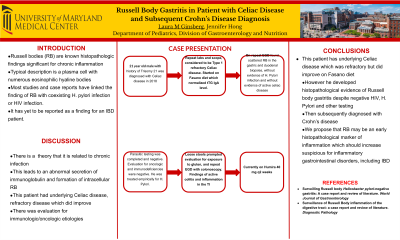Sunday Poster Session
Category: IBD
P0980 - Russell Body Gastritis in Patient With Celiac Disease and Subsequent Crohn's Disease Diagnosis
Sunday, October 27, 2024
3:30 PM - 7:00 PM ET
Location: Exhibit Hall E

- LG
Laura M. Ginsberg, DO
University of Maryland Medical System
Baltimore, MD
Presenting Author(s)
Laura M. Ginsberg, DO1, Jennifer Hong, MD2
1University of Maryland Medical System, Baltimore, MD; 2University of Maryland School of Medicine, Baltimore, MD
Introduction: Russell bodies (RB) are known histopathologic findings significant for chronic inflammation. The typical description is a plasma cell with numerous eosinophilic hyaline bodies. Most studies and case reports have linked the finding of RB with coexisting H. pylori infection or HIV infection. The theory is that chronic infection leads to an abnormal secretion of immunoglobulin and formation of intracellular RB. It has yet to be reported as a finding for an IBD patient. We describe a case of a patient who had findings of RB gastritis, which preceded IBD diagnosis and propose this as a precursor of inflammatory findings of IBD.
Case Description/Methods: A 21 year old male with history of Trisomy 21 was diagnosed with Celiac disease in 2018. He had elevated tTG IgA and evidence of duodenal villous atrophy, which persisted as small bowel damage consistent with Type 1 refractory Celiac disease. He was started on the Fasano diet and had tTG IgA level normalize. A repeat EGD in 2021 with strict adherence to the Fasano diet, found scattered RB in the gastric and duodenal biopsies, without evidence of H. Pylori infection and without evidence of active celiac disease. Due to a recent travel history, parasitic testing was completed and negative. Evaluation for oncologic and immunodeficiencies were negative. He was treated empirically for H. Pylori. The patient developed abdominal pain with loose bowel movements and concern for probable gluten exposure while at school. He was found with elevated tTG IgA which was previously normal in 2021 at the time of his prior EGD.
He underwent EGD and colonoscopy in 2022 with findings of mild chronic inflammation and mild to moderate distortion of the villous architecture in the duodenum; moderate inflammation in the antrum and body as well as mild to moderate esophagitis. There were findings of active inflammation from the TI to the descending colon and mild edema in the sigmoid and rectum. He was started on Humira 40 mg every 2 weeks for treatment of Crohn’s disease.
Discussion: Our goal is to bring awareness to the finding of Russel bodies on histopathologic review. This case describes a patient with type 1 refractory Celiac disease which then remitted on a Fasano diet. However, he developed histopathological evidence of Russell body gastritis which preceded Crohn’s disease diagnosis by several months. We propose that RB may be an early histopathological marker of inflammation which should increase suspicion for inflammatory gastrointestinal disorders including IBD.
Disclosures:
Laura M. Ginsberg, DO1, Jennifer Hong, MD2. P0980 - Russell Body Gastritis in Patient With Celiac Disease and Subsequent Crohn's Disease Diagnosis, ACG 2024 Annual Scientific Meeting Abstracts. Philadelphia, PA: American College of Gastroenterology.
1University of Maryland Medical System, Baltimore, MD; 2University of Maryland School of Medicine, Baltimore, MD
Introduction: Russell bodies (RB) are known histopathologic findings significant for chronic inflammation. The typical description is a plasma cell with numerous eosinophilic hyaline bodies. Most studies and case reports have linked the finding of RB with coexisting H. pylori infection or HIV infection. The theory is that chronic infection leads to an abnormal secretion of immunoglobulin and formation of intracellular RB. It has yet to be reported as a finding for an IBD patient. We describe a case of a patient who had findings of RB gastritis, which preceded IBD diagnosis and propose this as a precursor of inflammatory findings of IBD.
Case Description/Methods: A 21 year old male with history of Trisomy 21 was diagnosed with Celiac disease in 2018. He had elevated tTG IgA and evidence of duodenal villous atrophy, which persisted as small bowel damage consistent with Type 1 refractory Celiac disease. He was started on the Fasano diet and had tTG IgA level normalize. A repeat EGD in 2021 with strict adherence to the Fasano diet, found scattered RB in the gastric and duodenal biopsies, without evidence of H. Pylori infection and without evidence of active celiac disease. Due to a recent travel history, parasitic testing was completed and negative. Evaluation for oncologic and immunodeficiencies were negative. He was treated empirically for H. Pylori. The patient developed abdominal pain with loose bowel movements and concern for probable gluten exposure while at school. He was found with elevated tTG IgA which was previously normal in 2021 at the time of his prior EGD.
He underwent EGD and colonoscopy in 2022 with findings of mild chronic inflammation and mild to moderate distortion of the villous architecture in the duodenum; moderate inflammation in the antrum and body as well as mild to moderate esophagitis. There were findings of active inflammation from the TI to the descending colon and mild edema in the sigmoid and rectum. He was started on Humira 40 mg every 2 weeks for treatment of Crohn’s disease.
Discussion: Our goal is to bring awareness to the finding of Russel bodies on histopathologic review. This case describes a patient with type 1 refractory Celiac disease which then remitted on a Fasano diet. However, he developed histopathological evidence of Russell body gastritis which preceded Crohn’s disease diagnosis by several months. We propose that RB may be an early histopathological marker of inflammation which should increase suspicion for inflammatory gastrointestinal disorders including IBD.
Disclosures:
Laura Ginsberg indicated no relevant financial relationships.
Jennifer Hong indicated no relevant financial relationships.
Laura M. Ginsberg, DO1, Jennifer Hong, MD2. P0980 - Russell Body Gastritis in Patient With Celiac Disease and Subsequent Crohn's Disease Diagnosis, ACG 2024 Annual Scientific Meeting Abstracts. Philadelphia, PA: American College of Gastroenterology.
